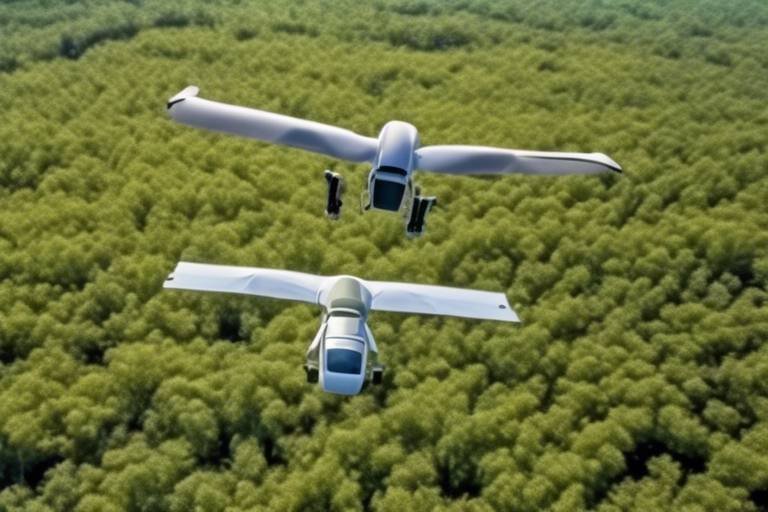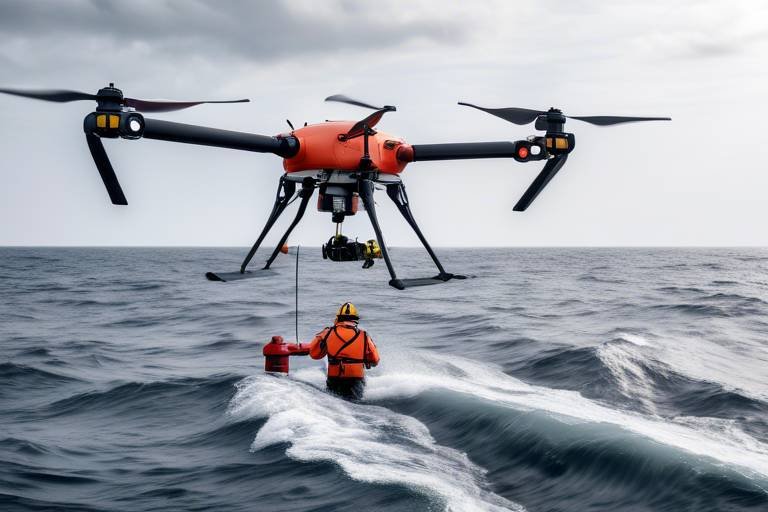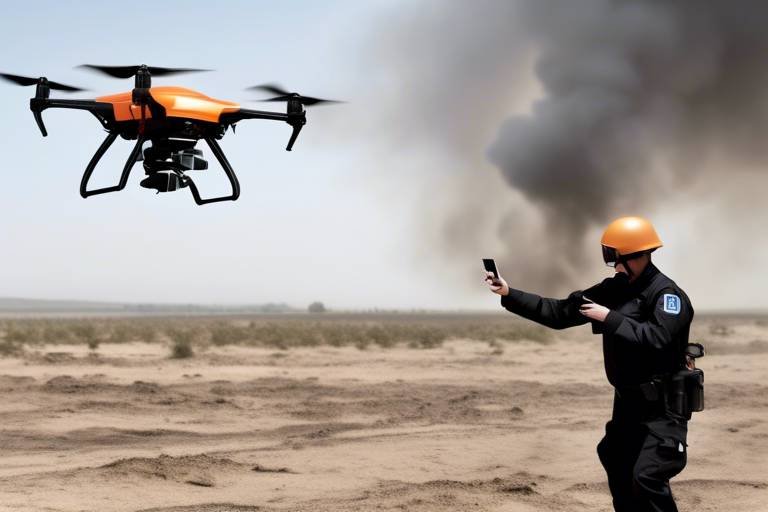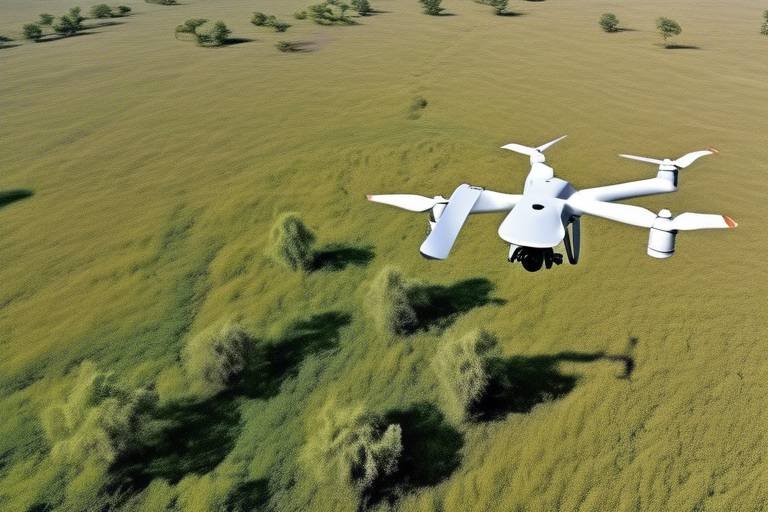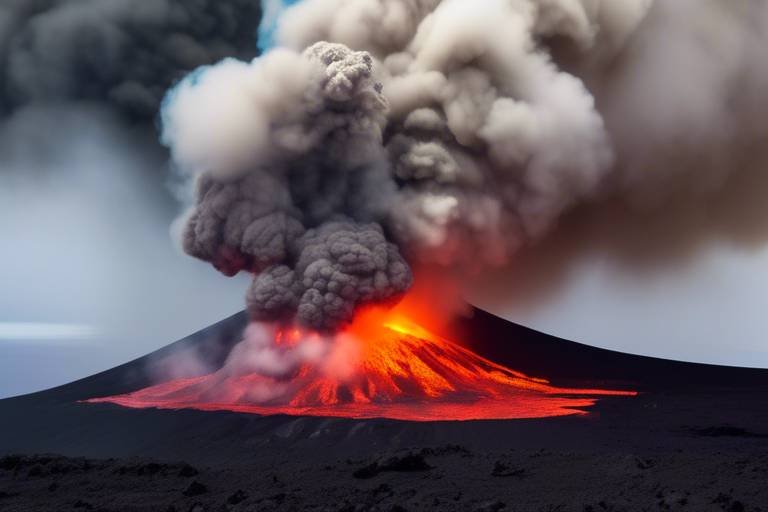Exploring the Role of Unmanned Systems in Enhancing Environmental Protection Efforts
The world we live in is facing unprecedented environmental challenges, and the need for effective solutions has never been greater. Enter unmanned systems, a groundbreaking technology that is transforming the landscape of environmental protection. These systems, which include drones and autonomous vehicles, are not just gadgets; they are powerful tools that are reshaping how we monitor, assess, and conserve our natural resources. Imagine soaring high above a dense forest, capturing real-time data on wildlife populations without ever disturbing their habitat. This is the magic of unmanned systems, and it's revolutionizing conservation strategies across the globe.
As we delve deeper into this topic, it's essential to understand what unmanned systems are and how they operate. These technologies function without direct human control, utilizing advanced sensors, cameras, and software to gather and analyze data. This capability allows environmentalists to tackle pressing issues like habitat destruction, pollution, and wildlife poaching with unprecedented efficiency and accuracy. The implications are vast, from enhancing our understanding of ecosystem dynamics to providing timely interventions that can save endangered species.
Moreover, the integration of unmanned systems into environmental protection efforts is not just about technology; it's about fostering a deeper connection with our planet. By leveraging these tools, we can gain insights that were previously unattainable, enabling us to make informed decisions that prioritize sustainability. In a world where every second counts, the ability to monitor and respond to environmental threats in real-time can be the difference between preservation and loss.
In the following sections, we will explore the myriad applications of unmanned systems in wildlife conservation, disaster response, and the challenges that come with their implementation. Each of these areas highlights the potential of these innovative technologies to make a significant impact on our environment. So, buckle up as we embark on this exciting journey into the world of unmanned systems and their role in safeguarding our planet!
- What are unmanned systems? Unmanned systems are technologies that operate without direct human control, such as drones and autonomous vehicles, used for various applications including environmental monitoring and conservation.
- How do drones help in wildlife conservation? Drones provide a non-intrusive way to monitor wildlife populations and habitats, enabling researchers to gather data without disturbing ecosystems.
- What challenges do unmanned systems face? Challenges include regulatory hurdles, technological limitations, and ethical considerations that must be navigated for effective implementation.
- Can unmanned systems assist in disaster response? Yes, they play a crucial role in assessing damage from natural disasters and enhancing search and rescue operations.
Introduction to Unmanned Systems
Unmanned systems are revolutionizing the way we approach various challenges in today's world, particularly in the realm of environmental protection. These innovative technologies, which include drones, autonomous vehicles, and other robotic systems, operate without direct human control. Imagine a world where a small drone can fly over vast forests, capturing data that would take a team of researchers weeks to collect on foot. This capability not only enhances efficiency but also minimizes the disturbance to sensitive ecosystems.
Understanding the capabilities of unmanned systems is essential for recognizing their impact on environmental protection initiatives. These systems can be deployed in various scenarios, providing real-time data, monitoring wildlife, and even assisting in disaster response. The integration of unmanned systems into environmental strategies is akin to having a highly skilled assistant at your side, always ready to gather information and provide insights that would otherwise be out of reach.
Unmanned systems come equipped with a variety of sensors and cameras, allowing them to capture detailed information about the environment. For instance, they can measure temperature, humidity, and even pollution levels in real-time. This data is crucial for scientists and conservationists as they strive to understand the complex interactions within ecosystems. By employing these technologies, researchers can focus on analysis and strategy development rather than spending countless hours on data collection.
Moreover, unmanned systems have the potential to enhance collaboration across various sectors. For example, environmental agencies, non-profits, and academic institutions can share data collected by drones, leading to a more comprehensive understanding of environmental issues. This collaborative approach is essential in tackling global challenges such as climate change, habitat destruction, and biodiversity loss.
In summary, unmanned systems represent a significant advancement in environmental monitoring and protection. Their ability to operate autonomously and gather critical data enhances our capacity to respond to ecological challenges effectively. As we continue to explore the potential of these technologies, it is clear that they will play a pivotal role in shaping the future of environmental conservation.
Applications in Wildlife Conservation
The integration of unmanned systems into wildlife conservation efforts has opened up a new frontier in environmental protection. These technologies, particularly drones and autonomous vehicles, allow researchers and conservationists to monitor wildlife populations and their habitats with unprecedented efficiency and precision. Imagine being able to observe rare species without ever stepping foot in their delicate ecosystem! This non-intrusive approach not only minimizes human impact but also provides critical data that can influence conservation strategies.
One of the standout applications of unmanned systems in wildlife conservation is their ability to conduct drone surveillance for poaching prevention. In regions where poaching threatens endangered species, drones equipped with high-resolution cameras and advanced sensors can patrol vast areas that would be otherwise inaccessible. These drones can cover large swathes of land in a fraction of the time it would take ground teams, enabling conservationists to detect suspicious activities and respond quickly to potential threats.
Using drones for surveillance is akin to having a pair of watchful eyes in the sky. These aerial guardians can monitor protected areas continuously, providing real-time feedback to ground teams. For instance, if a drone spots an illegal activity, conservationists can be alerted immediately, allowing them to intervene before any harm is done. This proactive approach is essential in the fight against poaching, where every second counts.
Another advantage of employing unmanned systems in wildlife conservation is the capacity for real-time data collection. Drones can gather a wealth of information, from tracking animal movements to assessing habitat conditions, all while minimizing disturbance to the environment. This data is invaluable; it allows conservationists to make informed decisions and implement timely interventions. Imagine being able to track a herd of elephants as they migrate, understanding their patterns, and ensuring their safe passage through human-dominated landscapes!
Moreover, unmanned systems excel in habitat mapping and analysis. By utilizing high-resolution imaging and remote sensing technologies, researchers can create detailed maps of ecosystems, revealing crucial insights into their health and biodiversity. This information is pivotal for effective conservation planning. For example, if a drone identifies areas of deforestation or habitat degradation, conservationists can prioritize these regions for restoration efforts. It's like having a map that not only shows where the treasure is buried but also highlights the threats to its existence.
In summary, the applications of unmanned systems in wildlife conservation are both extensive and impactful. From preventing poaching through vigilant aerial surveillance to facilitating real-time data collection and habitat analysis, these technologies are revolutionizing how we protect our planet's precious wildlife. As we continue to explore and innovate, the potential for unmanned systems in conservation seems boundless, paving the way for a future where humans and wildlife can coexist harmoniously.
Drone Surveillance for Poaching Prevention
In the battle against poaching, drones have emerged as a game-changing ally for conservationists. These unmanned aerial vehicles (UAVs) are not just flying gadgets; they are powerful tools that provide a bird's-eye view of some of the most remote and vulnerable ecosystems on the planet. Imagine being able to monitor vast stretches of protected land without ever setting foot on it! Drones equipped with high-resolution cameras and sophisticated sensors can cover large areas quickly, offering real-time surveillance that was once unimaginable. This capability is crucial for identifying and deterring poaching activities before they escalate.
One of the most compelling aspects of drone surveillance is its ability to operate in challenging terrains where human presence might disrupt wildlife. For example, in dense forests or rugged mountains, traditional patrols can be intrusive and ineffective. Drones, on the other hand, can glide silently above, capturing detailed images and videos that help conservationists assess wildlife populations and spot potential threats. This not only enhances the safety of the animals but also provides researchers with invaluable data that can inform their conservation strategies.
Additionally, the integration of thermal imaging technology into drones has revolutionized the way we detect poachers. By identifying heat signatures in the dark, drones can locate illegal hunters even under the cover of night. This capability is particularly significant in regions where poaching is rampant, allowing for timely interventions. For instance, in areas like Africa's wildlife reserves, drones have been instrumental in reducing poaching incidents, leading to a noticeable increase in the populations of endangered species.
Furthermore, the data collected by drones can be analyzed to create detailed maps of wildlife movements and habitat use. This information is essential for understanding animal behavior and developing effective conservation plans. By knowing where animals are most vulnerable or where poachers are likely to strike, conservationists can allocate resources more efficiently and implement targeted protection measures. The use of drones is not just about surveillance; it's about creating a comprehensive strategy that blends technology with traditional conservation efforts.
However, the use of drones in poaching prevention is not without its challenges. Issues such as privacy concerns and the need for regulatory compliance must be addressed. Conservation organizations must work closely with local authorities to ensure that drone operations are conducted ethically and transparently. Despite these challenges, the potential benefits of drone surveillance in the fight against poaching are undeniable, marking a significant step forward in protecting our planet's precious wildlife.
- How do drones help in wildlife conservation? Drones provide real-time monitoring, data collection, and surveillance to protect wildlife from poaching and habitat destruction.
- What technology is used in drones for poaching prevention? Drones often use high-resolution cameras and thermal imaging to detect poachers and monitor wildlife activity.
- Are there legal issues associated with drone surveillance? Yes, regulations regarding drone usage vary by region and must be adhered to in order to ensure ethical practices.
- Can drones operate in difficult terrains? Absolutely! Drones are designed to navigate challenging landscapes, making them ideal for monitoring remote areas.
Real-time Data Collection
In the realm of wildlife conservation, has emerged as a game-changer, enabling conservationists to monitor and protect threatened species with unprecedented efficiency. Imagine being able to gather critical information about animal movements, habitat conditions, and even poaching activities in the blink of an eye! Drones equipped with advanced sensors and high-resolution cameras are at the forefront of this technological revolution, allowing researchers to collect data without physically intruding on natural habitats.
One of the most remarkable aspects of real-time data collection is its ability to provide immediate insights. For instance, when a drone flies over a designated wildlife reserve, it can capture images and gather data that reveal changes in animal behavior or habitat degradation almost instantly. This immediacy is crucial when it comes to making informed decisions. If a drone detects unusual patterns, such as a sudden decrease in animal populations or signs of illegal activity, conservation teams can spring into action, deploying resources where they are needed most.
Furthermore, the integration of geospatial technologies with unmanned systems enhances the quality of data collected. By utilizing GPS and other mapping tools, conservationists can create detailed visualizations of wildlife movements and habitat changes over time. This data not only aids in immediate response efforts but also contributes to long-term conservation strategies. For example, patterns identified through this data can inform habitat restoration projects, ensuring that efforts are focused on the most critical areas.
To illustrate the impact of real-time data collection through unmanned systems, consider the following table that highlights key benefits:
| Benefit | Description |
|---|---|
| Timely Interventions | Enables swift action to protect vulnerable species from threats. |
| Enhanced Data Accuracy | Provides precise measurements and observations that improve research quality. |
| Cost-Effectiveness | Reduces the need for extensive manned field operations, saving time and resources. |
Moreover, the ability to collect data in real-time allows for the continuous monitoring of ecosystems, creating a feedback loop that can inform ongoing conservation efforts. For example, if a drone identifies a decline in water quality in a specific area, conservationists can quickly investigate and implement measures to address the issue before it escalates into a larger crisis. This proactive approach is essential in today's rapidly changing environmental landscape.
In conclusion, real-time data collection through unmanned systems not only enhances the efficiency of conservation efforts but also empowers teams to make evidence-based decisions that can significantly impact wildlife protection. As technology continues to evolve, the potential for even more sophisticated data collection methods will undoubtedly further revolutionize the field of environmental conservation.
- What types of unmanned systems are used for environmental protection?
Drones and autonomous vehicles are the most common unmanned systems utilized in environmental protection, offering various capabilities for monitoring and data collection.
- How do drones help in wildlife conservation?
Drones assist in wildlife conservation by providing real-time surveillance, monitoring animal populations, and gathering data without disturbing ecosystems.
- What are the challenges associated with using unmanned systems?
Challenges include regulatory hurdles, technological limitations, and ethical considerations that must be addressed for effective implementation.
Habitat Mapping and Analysis
In the realm of environmental protection, have become pivotal in understanding the intricate relationships within ecosystems. Unmanned systems, particularly drones, offer a bird's-eye view that is invaluable for conservationists and researchers alike. These aerial platforms can capture high-resolution images and gather data that would be nearly impossible to obtain from the ground. Imagine trying to map a sprawling forest or a vast wetland without the ability to soar above it; it's a daunting task! However, with the advent of unmanned systems, this challenge transforms into a manageable endeavor.
One of the primary advantages of using drones for habitat mapping is their ability to cover large areas quickly and efficiently. Traditional methods, such as ground surveys, can be labor-intensive and time-consuming, often requiring teams of people to traverse rugged terrains. Drones, on the other hand, can be deployed rapidly, collecting data in a fraction of the time. This efficiency not only saves time but also reduces the disturbance to wildlife and their habitats, which is crucial for maintaining ecological balance.
Moreover, unmanned systems can be equipped with various sensors to analyze different environmental parameters. For instance, thermal cameras can detect heat patterns, helping to identify areas of wildlife activity or stress. Multispectral sensors can provide insights into vegetation health, indicating how well plants are thriving in their environment. By analyzing this data, conservationists can make informed decisions regarding habitat management and restoration efforts.
To illustrate the impact of habitat mapping through unmanned systems, consider the following table that outlines the benefits and applications:
| Benefit | Application |
|---|---|
| Rapid Data Collection | Mapping large areas in short timeframes |
| Reduced Human Disturbance | Minimizing impact on wildlife during surveys |
| Advanced Sensor Technology | Gathering diverse data types for comprehensive analysis |
| Cost-Effective | Lower operational costs compared to traditional methods |
In conclusion, habitat mapping and analysis using unmanned systems not only enhances our understanding of ecosystems but also empowers conservationists with the tools they need to protect our planet's biodiversity. As technology continues to evolve, the potential for these systems to contribute to environmental protection efforts will only grow, opening new avenues for research and conservation strategies. The future looks promising, and with the right applications, we can ensure that our natural habitats thrive for generations to come.
- What are unmanned systems?
Unmanned systems refer to technologies that operate without direct human control, including drones and autonomous vehicles.
- How do drones help in wildlife conservation?
Drones assist in monitoring wildlife populations and habitats without disturbing the ecosystems, providing crucial data for conservation efforts.
- What are the benefits of habitat mapping?
Habitat mapping helps in understanding ecosystem health, planning conservation strategies, and monitoring changes over time.
- Are there any challenges associated with unmanned systems?
Yes, challenges include regulatory hurdles, technological limitations, and ethical considerations that need to be addressed for effective implementation.
Monitoring Ecosystem Health
Monitoring ecosystem health is crucial in today's world, where environmental challenges are escalating at an alarming rate. Unmanned systems, particularly drones and autonomous vehicles, have emerged as game-changers in this field. Imagine having the ability to assess the health of forests, rivers, and wildlife habitats without disturbing the very ecosystems you aim to protect. That's the power of unmanned systems!
These advanced technologies allow researchers and environmentalists to gather data on various ecological parameters, such as air quality, water quality, and biodiversity. For instance, drones equipped with sophisticated sensors can fly over vast areas, capturing real-time data that provides invaluable insights into the health of ecosystems. This data can reveal pollution levels, the presence of invasive species, and even the effects of climate change on local flora and fauna.
One of the standout features of unmanned systems is their ability to operate in hard-to-reach areas. For example, dense forests or remote wetlands can be challenging to monitor using traditional methods. Drones can easily navigate these environments, providing a bird's-eye view of ecological changes. This capability not only enhances the accuracy of data collection but also minimizes human impact on sensitive habitats.
Moreover, the integration of unmanned systems with artificial intelligence (AI) can take ecosystem monitoring to the next level. AI algorithms can analyze the collected data, identifying patterns and trends that might be overlooked by human analysts. This synergy between technology and ecology is paving the way for more informed conservation strategies.
In addition to monitoring, unmanned systems can play a critical role in proactive environmental management. By continuously tracking environmental indicators, conservationists can detect early signs of distress within an ecosystem. For instance, a sudden decrease in water quality could signal pollution from nearby agricultural activities. With timely intervention, stakeholders can address these issues before they escalate into larger problems.
The applications of unmanned systems in monitoring ecosystem health are vast and varied. Here are some key areas where they make a significant impact:
- Air Quality Monitoring: Drones can measure pollutants and particulate matter in the atmosphere, helping to identify sources of air pollution.
- Water Quality Assessment: Unmanned vehicles can collect water samples and use sensors to analyze chemical compositions, ensuring the safety of aquatic ecosystems.
- Biodiversity Surveys: Drones equipped with cameras can capture images of wildlife, allowing researchers to estimate population sizes and monitor species diversity.
In conclusion, unmanned systems are revolutionizing the way we monitor ecosystem health. Their ability to gather real-time data, coupled with advanced analytical tools, equips conservationists with the insights needed to protect our planet. As technology continues to evolve, the potential for unmanned systems to enhance environmental protection efforts will only grow, making them indispensable allies in the fight against ecological degradation.
Q1: How do unmanned systems help in monitoring air quality?
A1: Unmanned systems like drones can be equipped with sensors that detect various air pollutants, providing real-time data on air quality in different regions.
Q2: Can drones be used in remote areas for ecosystem monitoring?
A2: Yes! Drones are particularly effective in reaching remote or difficult terrains, allowing for comprehensive monitoring without disturbing the ecosystem.
Q3: What role does AI play in ecosystem monitoring?
A3: AI can analyze the vast amounts of data collected by unmanned systems, identifying trends and patterns that help in making informed conservation decisions.
Q4: Are there any limitations to using unmanned systems for monitoring?
A4: While unmanned systems provide many advantages, they can face challenges such as regulatory restrictions, technological constraints, and the need for trained personnel to operate and interpret data.
Disaster Response and Management
In a world where natural disasters seem to be occurring with increasing frequency and intensity, the role of unmanned systems in disaster response and management cannot be overstated. These technologies, particularly drones and autonomous vehicles, are transforming how we assess damage, coordinate recovery efforts, and ultimately save lives. Imagine a scenario where a hurricane has just made landfall, wreaking havoc on communities and ecosystems alike. In such dire situations, every second counts, and unmanned systems can provide critical support that traditional methods simply cannot match.
One of the most significant advantages of using unmanned systems in disaster scenarios is their ability to quickly assess damage from a bird's-eye view. Drones equipped with high-resolution cameras can fly over affected areas, capturing real-time images and videos that reveal the extent of destruction. This rapid data collection enables emergency response teams to prioritize their efforts effectively. For instance, if a drone reveals that a particular area has sustained severe flooding, rescue teams can be dispatched immediately, ensuring that help reaches those in need as swiftly as possible.
Moreover, unmanned systems are not just limited to aerial surveillance. They can also be deployed on the ground, providing critical insights into the condition of infrastructure and the environment. For example, autonomous vehicles can traverse hazardous terrains that humans cannot safely navigate, collecting data on soil stability, water contamination, and other vital parameters. This information is essential for formulating a comprehensive recovery strategy that addresses both immediate needs and long-term ecological impacts.
The integration of unmanned systems into disaster response is a game-changer, but it also comes with its own set of challenges. For instance, the coordination between various agencies can be complicated. Effective communication is crucial to ensure that the data collected is utilized efficiently. In many cases, agencies may not be familiar with the capabilities of unmanned systems, which can lead to underutilization or miscommunication during critical moments. Addressing these challenges requires ongoing training and collaboration among stakeholders.
To illustrate the profound impact of unmanned systems in disaster management, consider the following table that outlines some key applications and their benefits:
| Application | Benefits |
|---|---|
| Damage Assessment | Rapid evaluation of affected areas, enabling swift response. |
| Search and Rescue | Improved response times and increased chances of saving lives. |
| Environmental Monitoring | Assessing the impact on ecosystems and planning recovery efforts. |
| Infrastructure Inspection | Identifying hazards and ensuring safety for recovery operations. |
In conclusion, the role of unmanned systems in disaster response and management is not just a technological advancement; it represents a new paradigm in how we approach crises. By harnessing the power of these innovative tools, we can enhance our preparedness, response, and recovery efforts, ultimately leading to more resilient communities. As we continue to navigate the challenges posed by natural disasters, the integration of unmanned systems will undoubtedly play a pivotal role in shaping our future strategies for environmental protection and disaster management.
- How do drones assist in disaster response?
Drones provide real-time aerial imagery, enabling quick assessments of damage and helping prioritize rescue efforts. - Can unmanned systems operate in hazardous environments?
Yes, unmanned systems can traverse dangerous terrains, collecting vital data without putting human lives at risk. - What are the challenges of using unmanned systems in disaster management?
Challenges include regulatory issues, the need for inter-agency coordination, and ensuring that all stakeholders understand the technology's capabilities. - How can communities prepare for disasters using unmanned systems?
Communities can invest in training and resources to effectively utilize unmanned systems for monitoring and response during emergencies.
Assessing Damage from Natural Disasters
When disaster strikes, whether it’s a hurricane, earthquake, or wildfire, the immediate aftermath can be chaotic and overwhelming. One of the most critical aspects of recovery is assessing the damage, and this is where unmanned systems, particularly drones, come into play. Imagine being able to survey vast areas of land within minutes, capturing high-resolution images and real-time data without putting human lives at risk. This innovative approach not only speeds up the assessment process but also provides a level of detail that traditional methods often miss.
Drones equipped with advanced imaging technology, such as infrared cameras and multispectral sensors, can quickly identify areas most affected by natural disasters. For instance, after a flood, a drone can fly over the affected region, capturing images that reveal the extent of water damage to homes and infrastructure. This data is invaluable for emergency responders and government agencies as they prioritize their recovery efforts. By quickly identifying the hardest-hit areas, resources can be allocated more effectively, ensuring that help reaches those who need it most.
Moreover, the ability to collect data from hard-to-reach locations is another significant advantage of using unmanned systems. In the aftermath of a landslide or a wildfire, accessing certain areas can be dangerous or even impossible for human teams. Drones can navigate these hazardous environments, providing crucial information without risking human lives. This capability not only enhances safety but also allows for a more comprehensive understanding of the disaster's impact.
To illustrate the effectiveness of unmanned systems in disaster assessments, consider the following table that highlights key benefits:
| Benefit | Description |
|---|---|
| Speed | Drones can cover large areas quickly, providing immediate data for decision-making. |
| Safety | Reduces the risk to human life by accessing dangerous or unstable areas. |
| Detail | High-resolution imaging allows for precise assessments of damage. |
| Cost-Effectiveness | Using drones can be more economical than deploying large teams or helicopters. |
In addition to immediate damage assessment, unmanned systems also play a vital role in long-term recovery and planning. By analyzing the data collected during the assessment phase, agencies can develop strategic plans to rebuild and improve resilience against future disasters. This proactive approach not only addresses the immediate aftermath but also lays the groundwork for better preparedness in the future.
In conclusion, the integration of unmanned systems into disaster response strategies is revolutionizing the way we assess and manage the aftermath of natural disasters. As technology continues to advance, the potential for these systems to enhance our environmental protection efforts becomes even more profound. The ability to gather data quickly, safely, and accurately is not just a technological marvel; it’s a lifeline in times of crisis.
- How do drones help in disaster recovery?
Drones provide rapid damage assessments, access hard-to-reach areas, and collect valuable data for recovery planning. - Are there any risks associated with using unmanned systems?
While drones enhance safety by minimizing human risk, they are subject to regulatory challenges and require skilled operators. - What types of sensors are used in disaster assessment drones?
Drones can be equipped with various sensors, including infrared, multispectral, and high-resolution cameras, depending on the assessment needs.
Search and Rescue Operations
Unmanned systems are transforming the landscape of search and rescue operations, making them more efficient and effective than ever before. Imagine a scenario where a natural disaster strikes, and traditional rescue teams are hampered by treacherous terrain or adverse weather conditions. This is where drones and autonomous vehicles come into play, providing a critical lifeline in the chaos. These technologies can quickly assess the situation from above, offering real-time data that can guide rescue efforts and save lives.
One of the standout advantages of using unmanned systems in search and rescue is their ability to cover vast areas in a fraction of the time it would take human teams. Equipped with high-resolution cameras and thermal imaging, drones can detect heat signatures, helping to locate missing persons even in dense forests or collapsed structures. The ability to fly at low altitudes means they can navigate challenging environments that would be impossible for ground crews.
Moreover, the integration of AI technology into unmanned systems enhances their capabilities. For instance, AI algorithms can analyze images captured by drones in real-time, identifying patterns and potential locations of survivors. This not only speeds up the search process but also increases the likelihood of successful rescues. In situations where every second counts, the rapid deployment of drones can make a significant difference.
In addition to locating individuals, unmanned systems can also deliver crucial supplies, such as food, water, and medical assistance, to those stranded or in need. This capability is particularly vital in disaster-stricken areas where traditional supply routes may be compromised. By utilizing drones for logistics, rescue teams can ensure that help reaches those who need it most, even when ground access is limited.
However, while the advantages are clear, there are still challenges to overcome. Regulatory hurdles can impede the deployment of drones in certain regions, and concerns regarding privacy and safety must be addressed. For instance, as drones fly over populated areas, there is a need for clear guidelines to ensure they do not infringe on personal privacy or create hazards for other aircraft.
In summary, unmanned systems are revolutionizing search and rescue operations by providing rapid response capabilities, enhancing situational awareness, and facilitating logistics in challenging environments. The future of rescue missions looks promising as technology continues to evolve, paving the way for more efficient and effective responses to emergencies.
- How do drones help in search and rescue operations? Drones provide aerial surveillance, locate missing persons using thermal imaging, and can deliver supplies to those in need.
- Are there any privacy concerns with using drones for search and rescue? Yes, there are concerns regarding privacy and safety that need to be addressed through proper regulations and guidelines.
- Can drones operate in bad weather? While many drones are designed to withstand light rain and wind, severe weather conditions can limit their operational capabilities.
- What kind of training is required for drone operators in rescue missions? Operators typically undergo specialized training to understand both the technical aspects of drone operation and the specific needs of search and rescue missions.
Challenges and Limitations
While the potential of unmanned systems in enhancing environmental protection is undeniable, there are several that must be navigated to realize their full potential. First and foremost, the regulatory landscape surrounding the use of drones and autonomous vehicles can be quite complex. Different regions have varying laws and regulations regarding airspace usage, privacy concerns, and wildlife protection, which can hinder the deployment of these technologies in certain areas. For instance, in some countries, obtaining the necessary permits for drone flights can be a lengthy and cumbersome process, often requiring extensive documentation and justification of their intended use.
Moreover, there are significant technological constraints that can limit the effectiveness of unmanned systems. Issues such as battery life and sensor capabilities pose challenges, particularly in remote or expansive areas where charging facilities are scarce. Drones might only be able to operate for a limited duration before requiring a recharge, which can be a critical disadvantage in situations requiring prolonged monitoring or extensive data collection. Additionally, the quality of the data collected is heavily dependent on the sensors used. If the sensors are not advanced enough, the data may not provide the detailed insights needed for effective environmental management.
Ethical considerations also play a significant role in the deployment of unmanned systems. The use of drones in wildlife monitoring, for example, raises questions about the potential for disturbance to the animals being observed. While these technologies are designed to minimize human impact, there is still a risk that the presence of drones could alter animal behavior or disrupt their natural habitats. Striking a balance between effective monitoring and maintaining ecological integrity is a challenge that conservationists must navigate.
In summary, while unmanned systems offer innovative solutions for environmental protection, addressing these challenges is crucial for their successful implementation. The interplay between regulatory frameworks, technological capabilities, and ethical considerations will determine how effectively these systems can be integrated into conservation strategies. As we continue to explore the potential of unmanned systems, it is essential to remain aware of these limitations and work towards overcoming them.
- What are unmanned systems?
Unmanned systems refer to technologies that operate without direct human control, including drones and autonomous vehicles, used for various applications in environmental protection.
- How do drones help in wildlife conservation?
Drones assist in monitoring animal populations and habitats, collecting data without disturbing ecosystems, and preventing poaching through surveillance.
- What challenges do unmanned systems face?
Challenges include regulatory hurdles, technological limitations such as battery life, and ethical considerations regarding wildlife disturbance.
- Can unmanned systems assess environmental damage after a disaster?
Yes, unmanned systems can quickly evaluate the impact of natural disasters on ecosystems, aiding in recovery and restoration efforts.
Regulatory and Legal Issues
The deployment of unmanned systems in environmental protection is not just a matter of technology; it is also deeply intertwined with regulatory and legal frameworks. As these technologies evolve, so too must the laws that govern their use. Different countries and regions have varying regulations that can significantly impact how unmanned systems are utilized for conservation efforts. For instance, in some places, the use of drones for wildlife monitoring may be restricted due to privacy concerns or airspace regulations. This can create a complex web of legal challenges that organizations must navigate.
One of the primary regulatory challenges is the lack of standardized policies across jurisdictions. In the United States, for example, the Federal Aviation Administration (FAA) has set guidelines for drone operations, but these can differ from state to state. Similarly, in Europe, the European Union Aviation Safety Agency (EASA) has its own set of rules that may not align with local laws. This inconsistency can lead to confusion and may deter organizations from fully utilizing unmanned systems for environmental monitoring. Moreover, the ethical implications of using drones—such as concerns about surveillance and data privacy—add another layer of complexity to the regulatory landscape.
To illustrate the regulatory landscape, consider the following table that outlines some of the key regulations in different regions:
| Region | Regulatory Body | Key Regulations |
|---|---|---|
| United States | Federal Aviation Administration (FAA) | Part 107 guidelines for commercial drone use |
| European Union | European Union Aviation Safety Agency (EASA) | EU Drone Regulation 2019/947 |
| Australia | Civil Aviation Safety Authority (CASA) | CASA's Remotely Piloted Aircraft Systems (RPAS) regulations |
Furthermore, organizations must also consider the ethical implications of their actions. The use of unmanned systems raises questions about the potential for invasion of privacy, especially if drones are equipped with high-resolution cameras. Conservationists must strike a balance between the need for data collection and the rights of individuals. This means that clear guidelines and ethical standards should be established to ensure that unmanned systems are used responsibly and transparently.
In conclusion, while unmanned systems offer tremendous potential for enhancing environmental protection efforts, the regulatory and legal challenges cannot be overlooked. It is crucial for stakeholders to engage in discussions with policymakers to shape regulations that not only facilitate the use of these technologies but also protect the rights of individuals and the integrity of ecosystems.
- What are unmanned systems? Unmanned systems refer to technologies that operate without direct human control, including drones and autonomous vehicles.
- How do drones help in wildlife conservation? Drones monitor animal populations and habitats, allowing researchers to gather data without disturbing ecosystems.
- What are the main regulatory challenges for unmanned systems? The lack of standardized policies across regions, privacy concerns, and ethical implications pose significant regulatory challenges.
- Why is ethical consideration important in using unmanned systems? Ethical considerations ensure that unmanned systems are used responsibly, respecting individual privacy and ecological integrity.
Technological Constraints
The rapid advancement of unmanned systems has opened up a world of possibilities for environmental protection, but it’s not all smooth sailing. There are significant that can limit the effectiveness of these systems. For instance, battery life remains a persistent issue. Most drones are designed for short flight durations, typically ranging from 20 to 30 minutes before needing a recharge. This limited operational time can be a major setback, especially in vast or remote areas where quick data collection is essential. Imagine trying to monitor a large wildlife reserve with a drone that can only stay airborne for half an hour; it’s like trying to catch a fleeting glimpse of a shooting star—beautiful but frustratingly brief.
Another constraint lies in the sensors and equipment used in these unmanned systems. While there have been remarkable advancements in imaging technology, not all drones are equipped with the high-resolution cameras or sophisticated sensors needed for specific environmental monitoring tasks. For example, detecting subtle changes in vegetation health or identifying specific pollutants in water bodies often requires specialized equipment that may not be available in standard drones. This limitation can lead to gaps in data, which in turn can hinder effective conservation strategies.
Moreover, weather conditions can pose a significant challenge. Drones are typically sensitive to wind, rain, and other adverse weather conditions, which can restrict their operational capabilities. Picture sending a drone out to survey a coastal area only to have it grounded by a sudden storm—this unpredictability can delay crucial data collection and response efforts.
Additionally, there are connectivity issues that can affect the performance of unmanned systems. In many remote locations, the lack of reliable internet or GPS signals can hinder real-time data transmission, making it difficult for conservationists to receive immediate updates. This is particularly critical in situations requiring rapid response, such as poaching incidents or natural disasters.
Finally, we must consider the cost of technology. While prices for drones and sensors have decreased over the years, high-quality systems equipped with advanced technology can still be prohibitively expensive for many conservation organizations. This financial barrier can limit the widespread adoption of unmanned systems in environmental protection efforts, particularly among smaller NGOs or community-based initiatives.
In summary, while unmanned systems hold immense potential for enhancing environmental protection efforts, addressing these technological constraints is crucial for their effective deployment. Overcoming these challenges will not only improve the capabilities of these systems but also pave the way for a more sustainable and efficient approach to conservation.
- What are unmanned systems? Unmanned systems refer to technologies like drones and autonomous vehicles that operate without direct human control.
- How do drones help in wildlife conservation? Drones are used to monitor animal populations, collect data, and deter poaching activities without disturbing ecosystems.
- What challenges do unmanned systems face? Challenges include regulatory hurdles, technological constraints, and ethical considerations that must be addressed for effective implementation.
- Can drones operate in bad weather? Drones are sensitive to adverse weather conditions, which can limit their operational capabilities.
- Why are unmanned systems important for disaster response? They provide critical data for assessing environmental damage and coordinating recovery efforts more efficiently.
Frequently Asked Questions
- What are unmanned systems?
Unmanned systems refer to technologies that can operate without direct human control, such as drones and autonomous vehicles. These systems are designed to perform various tasks, including data collection and monitoring, especially in environmental protection efforts.
- How do drones contribute to wildlife conservation?
Drones play a significant role in wildlife conservation by providing a way to monitor animal populations and their habitats without causing disturbance. They help researchers gather crucial data that can be used to protect endangered species and maintain biodiversity.
- What is the importance of real-time data collection?
Real-time data collection through drones allows conservationists to respond quickly to threats against wildlife. This capability ensures that timely interventions can be made, which is vital for protecting vulnerable species from poaching and habitat destruction.
- How are unmanned systems used in disaster response?
In disaster response, unmanned systems provide essential data for assessing environmental damage and coordinating recovery efforts. They can quickly evaluate the impact of natural disasters on ecosystems, helping agencies prioritize their recovery strategies effectively.
- What challenges do unmanned systems face in environmental protection?
Unmanned systems encounter several challenges, including regulatory hurdles, technological limitations, and ethical considerations. Addressing these issues is crucial for the effective implementation of these technologies in environmental protection initiatives.
- Are there legal issues associated with using drones?
Yes, the deployment of drones in environmental protection is subject to various regulatory and legal issues. Laws can vary significantly across regions, making it essential for operators to navigate the regulatory landscape carefully to ensure compliance.
- What are some technological constraints of unmanned systems?
Current technological limitations, such as battery life and sensor capabilities, can hinder the effectiveness of unmanned systems in certain applications. These constraints may affect their operational range and the quality of data collected.



